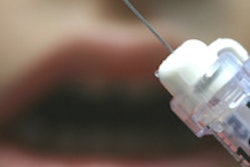
Are redheaded women really more likely to have an inferior alveolar nerve (IAN) block fail than others? Or is this a modern medical myth regarding the most frequently administered local anesthesia technique in restorative dentistry?
Researchers from Ohio State University set out to settle the matter in a study that yielded unanticipated results (Journal of Endodontics, December 2012, Vol. 38:12, pp. 1564-1569).
Their study involved 124 adult women who were in good health, younger than age 65, and not taking medications that would impact pain perception.
"Only women were used in this study because recent research has indicated that sex may play a role in the physiology and metabolism involved with pain perception, anesthesia, and analgesia in individuals with red hair and those with variant alleles in the MC1R [melanorcortin-1 receptor] gene," wrote the researchers, noting that the MC1R gene is where the specific mutation for red hair color (RHC) alleles resides.
Half of the study participants were red-haired and the other half were dark-haired. Women with gray or blond hair and women who colored their hair were excluded.
The test teeth involved were divided equally between the left and right mandibular sides; first and second molars and premolars and also lateral and central incisors served as the test teeth. A contralateral canine served as a control to check the operation of the pulp tester three times and the subject's response.
The test teeth were also examined to be sure they were clear of attributes that could skew the subject's reaction, such as caries, crowns, large restorations, or periodontal disease. Subsequently, each participant's level of anxiety was assessed with the Corah Dental Anxiety Scale.
Each subject received 2 cartridges of 2% lidocaine with 1:100,000 epinephrine (Dentsply Pharmaceutical/Oraqix) via the IAN block. Afterward, using the electric tester, the researchers measured pulpal anesthesia in the posterior and anterior teeth in 4-minute cycles for 1 hour. To gauge the subject's reliability, the control tooth was tested by a pulp tester without batteries; if the test yielded a positive response from the subject, she was deemed not reliable and not used in the study.
Next, the researchers genotyped the MC1R alleles for each participant with a buccal swab for the purposes of grouping their results. Those with "alleles strongly linked to the RHC phenotype ... were all considered RHC alleles." Later, among other comparisons gauging anesthetic success and pain levels, between-group comparisons for anxiety were performed with a randomized test.
Lidocaine link
The success rates of IAN blocks were unaffected by red hair and the MC1R gene, which would contradict previous studies of anesthetic-related features in red-haired women, the researchers noted. However, they did find significant differences in another area of the study. In particular, red hair and the MC1R gene were significantly linked to higher levels of dental anxiety, they wrote.
While red hair may seem like an arbitrary classification for the effectiveness of an IAN block, there is a link between red hair color and pain management with lidocaine. For example, previous research has reduced subcutaneous efficacy of lidocaine and increased sensitivity to thermal pain in female patients with red hair, the researchers noted. And other studies concluded that females with red hair have an increased requirement for desflurane compared with their peers.
While the researchers found no significant differences (p > 0.05) in anesthetic success for any of the teeth, they did find a disparity in dental anxiety. "Both red-haired women (p = 0.0011) and genotypic redheads, women with 2 RHC alleles (p = 0.0213), were shown to have significantly greater dental anxiety," the researchers wrote.
The mean levels of anxiety
|
Additionally, redheads -- but not genotypic redheads -- reported significantly greater pain on needle insertion, the researchers noted. Both groups reported greater pain for all 3 phases of the IAN block, the researchers stated, but they speculated that the response could be related to dental anxiety.
However, they found no significant differences in the reporting of pain during needle placement or solution deposition between each group.
"The IAN block has the potential to be a painful injection," the researchers acknowledged. But red hair and the MC1R gene "were unrelated to success rates of the IAN block in women with healthy pulps."



















